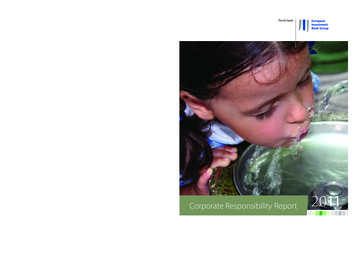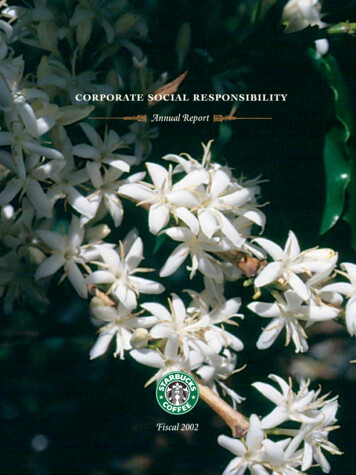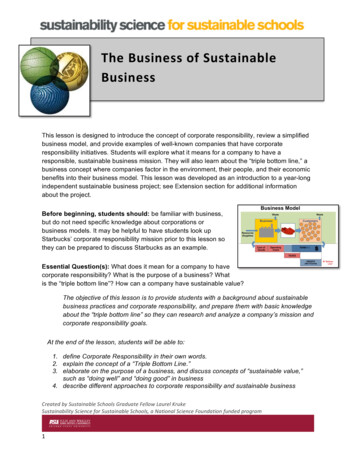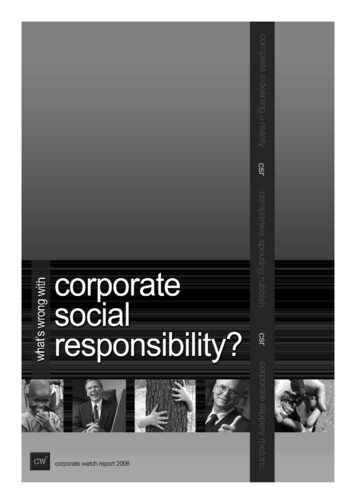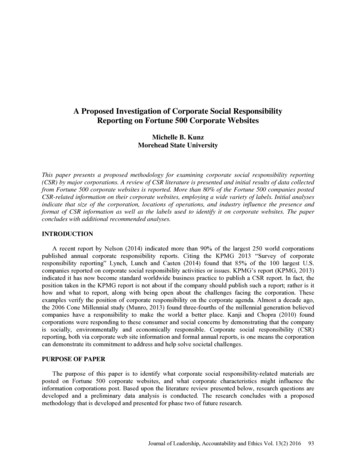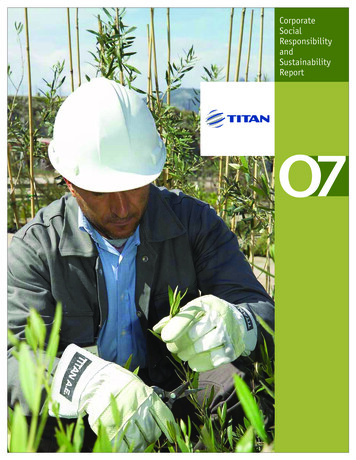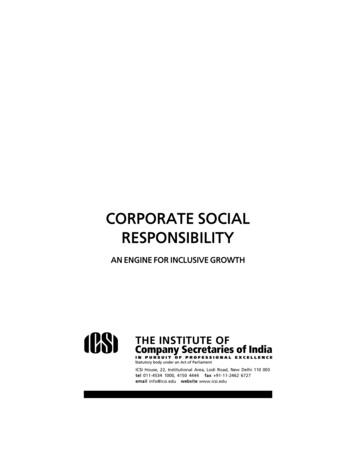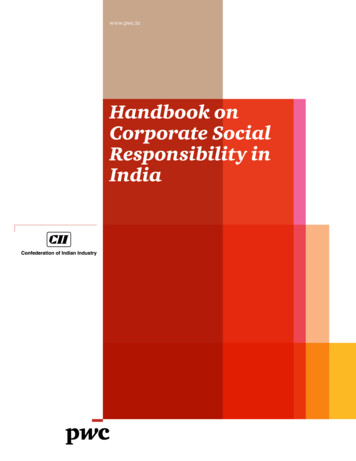
Transcription
www.pwc.inHandbook onCorporate SocialResponsibility inIndia
Message from the ChairmanCII’s Development Initiative CouncilA robust and thriving development sector is central to India’s quest for equitable, inclusiveand sustainable growth. India’s development sector has evolved substantially over the last fewdecades and is now witnessing unprecedented interest and investments across the value chain.With the passage of the Companies Act, 2013 the mandate for corporate social responsibility(CSR) has been formally introduced to the dashboard of the Boards of Indian companies. Theindustry has responded positively to the reform measure undertaken by the government with awide interest across the public and private sector, Indian and multinational companies.The practice of CSR is not new to companies in India. However, what this Act does is bringmore companies into the fold. Also, it is likely that the total CSR spends will increase. What isclear to many companies is that if this increased spending is to achieve results on the ground– which is the intent of the Act – then it needs to be done strategically, systematically andthoughtfully.It is in this context, that the ‘Handbook on Corporate Social Responsibility in India’ developedby PwC India for CII can play an important role. The CII being the leading industry body,through this handbook, envisages equipping companies for this shift of structured engagementwith communities. This handbook is aimed both at companies that are veteran CSRpractitioners as well as those that are just entering the fray. It suggests steps to develop a CSRstrategy and Policy and identifies the key building blocks for initiating and developing the CSRprograms. It walks the CSR practitioner through some of the key choices that may be requiredto be made while pursuing CSR objectives and develop an organisation that is socially sensitiveand responsible.Building a society which provides equal access to opportunities negates disparities and, is acollective responsibility. This Act presents a unique opportunity to stand up to the challenge. Itis a call for action. And this handbook is a significant step in that direction.Rakesh Bharti MittalChairman, CII’s Development Initiative Council andVice Chairman and Managing Director, Bharti Enterprises
Message from the Mentor andChairman EmeritusFortis Healthcare LimitedThe constitutional structure of the country was laid with an objective of one man equals onevote, equals one value. However the socio-economic realities of the country still have a longway to go to match this vision of independent India where today there are many first amongequals. The country presently is under intense debate of developmental growth versus welfarebased development. Our political realities and our economic senses are at cross-roads. How dowe strike a balance between the two? The choices we make today are going to influence ourgenerations to come.Every single major policy initiative in this country has been driven with a perspective that anoverwhelming concern for the disadvantaged and marginalised, a multidimensional view ofpoverty and human deprivation, the focus on our fundamental rights and the need to expandopportunities while ensuring its equal distribution are fundamental for achieving stronghuman development. But disparity, inequality and the growing divide in our societies defineour existence today. The inclusion of the CSR mandate under the Companies Act, 2013 is anattempt to supplement the governments efforts of equitably delivering the benefits of growthand to engage the Corporate World with the country’s development agenda.Philanthropy and CSR is not a novel concept for Indian companies, however a feworganisations are likely to struggle. The role of civil society in fuelling this change is bound tobe extremely important. With the new corporate resources in their tool bag much will dependon their ability to innovate and adapt.The handbook is a guidance document which will facilitate development of CSR mandatewithin organisations and help streamline dialogue within the industry. An addendum willfollow with details of the rules once the same have been notified by the Government. Themembers of the industry are likely to find their output helpful, informative and enabling.Confederation of Indian Industry has been in the forefront in sensitising industry on CSRand creating necessary enablers for promoting CSR for over a decade. I am confident that allcompanies will be immensely benefitted from this document too.I would like to extend my warm appreciation to the PwC team, including Sachin Shukla,Sharique Ahmad, Anjan Katna, Ankit Gupta and Shankar Venkateswaran who worked towardsthe development of this document.Harpal SinghMentor and Chairman Emeritus,Fortis Healthcare Limited
List of abbreviationsBRRBusiness Responsibility ReportCSRCorporate social responsibilityDPEDepartment of Public EnterprisesECEuropean CommissionESGEnvironmental, social and governanceILOInternational Labour OrganisationISOInternational Organisation for StandardisationLBGLondon Benchmarking Group modelMCAMinistry of Corporate AffairsNVGNational Voluntary GuidelinesOECDOrganisation for Economic Co-operation and DevelopmentSEBISecurities and Exchange Board of IndiaSMESmall and medium enterprisesSAASSocial accountability accreditation services11The Companies Act, 2013SGAAPSocial generally accepted accounting principles14CSR: Planning and strategisingSROISocial return on investmentsUNUnited Nations23CSR and SMEsUNGCUnited Nations Global Compact26AppendicesUNIDOUnited Nations Industrial Development OrganisationWBCSDWorld Business Council for Sustainable DevelopmentContents6What is CSR?
About the handbookIndia is a country of myriad contradictions. On the one hand, it has grown tobe one of the largest economies in the world, and an increasingly importantplayer in the emerging global order, on the other hand, it is still home to thelargest number of people living in absolute poverty (even if the proportionof poor people has decreased) and the largest number of undernourishedchildren. What emerges is a picture of uneven distribution of the benefits ofgrowth which many believe, is the root cause of social unrest.Companies too have been the target of those perturbed by this unevendevelopment and as a result, their contributions to society are undersevere scrutiny. With increasing awareness of this gap between the havesand the have-nots, this scrutiny will only increase over time and societalexpectations will be on the rise. Many companies have been quick to sensethis development, and have responded proactively while others have done soonly when pushed.Governments as well as regulators have responded to this unrest and theNational Voluntary Guidelines for Social, Environmental and EconomicResponsibilities of Business or the NVGs (accompanied by the BusinessResponsibility Reports mandated by the SEBI for the top 100 companies)and the CSR clause within the Companies Act, 2013 are two such instancesof the steps taken.According to Indian Institute of Corporate Affairs, a minimum of 6,000Indian companies will be required to undertake CSR projects in orderto comply with the provisions of the Companies Act, 2013 with manycompanies undertaking these initiatives for the first time. Further, someestimates indicate that CSR commitments from companies can amount to asmuch as 20,000 crore INR.This combination of regulatory as well as societal pressure has meantthat companies have to pursue their CSR activities more professionally.This handbook attempts to bring together good practices of companiesand grant-making foundations so as to assist companies pursue their CSRactivities effectively, while remaining aligned with the requirements of theCompanies Act, 2013.This handbook begins by building a common understanding of the conceptof CSR, based on global practices, Indian tradition, and the intent andprovisions of the Companies Act, 2013. It then goes on to bring out the keyaspects of clause 135 of the Companies Act, 2013 and the recently releaseddraft rules, and highlights its implications to companies.A major part of the handbook focuses on the ‘what’ and ‘how’ of strategising,planning, executing and monitoring the CSR activities of companies. Itprovides a detailed guidance (rather than prescriptions) for each of theseprocesses covering the following: Objective of the process Process owners Key inputs and outputs Activities or tasks to be covered, including methodology and timelines Tools, technical guidance or standards to be employedIt also has a section on what small and medium enterprises, some of whomwill be required to comply with the Act, can do collectively.
What is CSR?6PwC
What is CSR?The global contextWhile there may be no single universallyaccepted definition of CSR, each definitionthat currently exists underpins the impactthat businesses have on society at large andthe societal expectations of them. Althoughthe roots of CSR lie in philanthropicactivities (such as donations, charity,relief work, etc.) of corporations, globally,the concept of CSR has evolved and nowencompasses all related concepts such astriple bottom line, corporate citizenship,philanthropy, strategic philanthropy, sharedvalue, corporate sustainability and businessresponsibility. This is evident in some of thedefinitions presented below:The EC1 defines CSR as “the responsibility ofenterprises for their impacts on society”. Tocompletely meet their social responsibility,enterprises “should have in place a processto integrate social, environmental, ethicalhuman rights and consumer concerns intotheir business operations and core strategy inclose collaboration with their stakeholders”The WBCSD defines CSR as2 “the continuingcommitment by business to contribute toeconomic development while improving thequality of life of the workforce and theirfamilies as well as of the community andsociety at large.”According to the UNIDO3, “Corporatesocial responsibility is a managementconcept whereby companies integratesocial and environmental concerns intheir business operations and interactionswith their stakeholders. CSR is generallyunderstood as being the way through whicha company achieves a balance of economic,environmental and social imperatives(Triple-Bottom-Line Approach), while atthe same time addressing the expectationsof shareholders and stakeholders. In thissense it is important to draw a distinctionbetween CSR, which can be a strategicbusiness management concept, and charity,sponsorships or philanthropy. whatis-csr.html#pp1[g1]/0/Brundtland Commission’s Report, 1987though the latter can also make a valuablecontribution to poverty reduction, willdirectly enhance the reputation of a companyand strengthen its brand, the concept of CSRclearly goes beyond that.”From the above definitions, it is clear that: The CSR approach is holistic andintegrated with the core business strategyfor addressing social and environmentalimpacts of businesses. CSR needs to address the well-beingof all stakeholders and not just thecompany’s shareholders. Philanthropic activities are only a part ofCSR, which otherwise constitutes a muchlarger set of activities entailing strategicbusiness benefits.CSR in IndiaCSR in India has traditionally beenseen as a philanthropic activity. And inkeeping with the Indian tradition, it wasan activity that was performed but notdeliberated. As a result, there is limiteddocumentation on specific activities relatedto this concept. However, what was clearlyevident that much of this had a nationalcharacter encapsulated within it, whetherit was endowing institutions to activelyparticipating in India’s freedom movement,and embedded in the idea of trusteeship.As some observers have pointed out, thepractice of CSR in India still remains withinthe philanthropic space, but has moved frominstitutional building (educational, researchand cultural) to community developmentthrough various projects. Also, with globalinfluences and with communities becomingmore active and demanding, there appearsto be a discernible trend, that while CSRremains largely restricted to communitydevelopment, it is getting more strategic innature (that is, getting linked with business)than philanthropic, and a large number ofcompanies are reporting the activities theyare undertaking in this space in their officialwebsites, annual reports, sustainabilityreports and even publishing CSR reports.The Companies Act, 2013 has introducedthe idea of CSR to the forefront andthrough its disclose-or-explain mandate,is promoting greater transparency anddisclosure. Schedule VII of the Act, whichlists out the CSR activities, suggestscommunities to be the focal point. On theother hand, by discussing a company’srelationship to its stakeholders andintegrating CSR into its core operations,the draft rules suggest that CSR needsto go beyond communities and beyondthe concept of philanthropy. It will beinteresting to observe the ways in which thiswill translate into action at the ground level,and how the understanding of CSR is set toundergo a change.CSR and sustainabilitySustainability (corporate sustainability)is derived from the concept of sustainabledevelopment which is defined by theBrundtland Commission as “developmentthat meets the needs of the present withoutcompromising the ability of future generationsto meet their own needs” 4. Corporatesustainability essentially refers to the rolethat companies can play in meeting theagenda of sustainable development andentails a balanced approach to economicprogress, social progress and environmentalstewardship.CSR in India tends to focus on what isdone with profits after they are made. Onthe other hand, sustainability is aboutfactoring the social and environmentalimpacts of conducting business, that is,how profits are made. Hence, much of theIndian practice of CSR is an importantcomponent of sustainability or responsiblebusiness, which is a larger idea, a factthat is evident from various sustainabilityframeworks. An interesting case in pointis the NVGs for social, environmentaland economic responsibilities of businessissued by the Ministry of Corporate Affairsin June 2011. Principle eight relating toinclusive development encompasses mostof the aspects covered by the CSR clauseof the Companies Act, 2013. However, theremaining eight principles relate to otheraspects of the business. The UN GlobalCompact, a widely used sustainabilityframework has 10 principles coveringsocial, environmental, human rights andgovernance issues, and what is described asCSR is implicit rather than explicit in theseprinciples.Handbook on Corporate Social Responsibility in India7
Globally, the notion of CSR andsustainability seems to be converging, asis evident from the various definitions ofCSR put forth by global organisations. Thegenesis of this convergence can be observedfrom the preamble to the recently releaseddraft rules relating to the CSR clause withinthe Companies Act, 2013 which talksabout stakeholders and integrating it withthe social, environmental and economicobjectives, all of which constitute theidea of a triple bottom line approach. Itis also acknowledged in the Guidelineson Corporate Social Responsibility andSustainability for Central Public SectorEnterprises issued by the DPE in April 20135.The new guidelines, which have replacedtwo existing separate guidelines on CSRand sustainable development, issued in2010 and 2011 respectively, mentions thefollowing:“Since corporate social responsibility andsustainability are so closely entwined, it canbe said that corporate social responsibilityand sustainability is a company’s commitmentto its stakeholders to conduct business in aneconomically, socially and environmentallysustainable manner that is transparent andethical.”Why is the CSR clause of thenew Companies Act, 2013 socritical for SMEs?By requiring companies, with aminimum net profit of 5 crore INR,to spend on CSR activities, theCompanies Act, 2013 is likely to bringin many SMEs into the CSR fold. Thiswill usher in a fresh set of challengesto a sector that is increasinglybeing asked by its B2B customersto comply with environmental andsocial standards, while remainingcompetitive in terms of price andquality. Thus, SMEs will have toquickly learn to be compliant withthese diverse set of requirements andit is hoped that this handbook willfacilitate their ability to comply withthe CSR clause of the Companies Act,2013.58Guidelines on Corporate Social Responsibility andSustainability for Central Public Sector E Guidelines CSR Sust.pdfPwCBenefits of a robust CSRprogrammeAs the business environment getsincreasingly complex and stakeholdersbecome vocal about their expectations,good CSR practices can only bring in greaterbenefits, some of which are as follows: Communities provide the licence tooperate: Apart from internal driverssuch as values and ethos, some of the keystakeholders that influence corporatebehaviour include governments (throughlaws and regulations), investors andcustomers. In India, a fourth andincreasingly important stakeholder isthe community, and many companieshave started realising that the ‘licenceto operate’ is no longer given bygovernments alone, but communitiesthat are impacted by a company’sbusiness operations. Thus, a robust CSRprogramme that meets the aspirationsof these communities not only providesthem with the licence to operate, butalso to maintain the licence, therebyprecluding the ‘trust deficit’. Attracting and retaining employees:Several human resource studies havelinked a company’s ability to attract,retain and motivate employees withtheir CSR commitments. Interventionsthat encourage and enable employeesto participate are shown to increaseemployee morale and a sense ofbelonging to the company. Communities as suppliers: Thereare certain innovative CSR initiativesemerging, wherein companies haveinvested in enhancing communitylivelihood by incorporating them intotheir supply chain. This has benefittedcommunities and increased their incomelevels, while providing these companieswith an additional and secure supplychain. Enhancing corporate reputation:The traditional benefit of generatinggoodwill, creating a positive image andbranding benefits continue to exist forcompanies that operate effective CSRprogrammes. This allows companiesto position themselves as responsiblecorporate citizens.
Global principles and guidelinesA comprehensive guidance for companiespertaining to CSR is available in the formof several globally recognised guidelines,frameworks, principles and tools, some ofwhich are discussed below. It must be notedthat most of these guidelines relate to thelarger concept of sustainability or businessresponsibility, in keeping with the fact thatthese concepts are closely aligned globallywith the notion of CSR.UNGCUNGC is world’s largest corporate citizenshipinitiative with the objective to mainstream theadoption of sustainable and socially responsiblepolicies by businesses around the world. The 10principles of the UN Global Compact have beenderived from various UN conventions such asthe Universal Declaration of Human Rights,ILO’s Declaration on Fundamental Principlesand Rights at Work, the Rio Declaration onenvironment and development, and the UNConvention Against Corruption. These principles cover four broad areas: Human rights (support and respect theprotection of international human rightsand ensure that business is not complicitwith human rights abuses) Labour rights (uphold the freedom of association and effective recognition of theright to collective bargaining, eliminationof all forms of forced and compulsorylabour, effective abolition of child labourand elimination of description in respectof employment and occupation) Environment (support a precautionaryapproach to environmental challenges,undertake initiatives to promote greaterenvironmental responsibility and encourage the development of environmentalfriendly technology) Governance (work against corruption inall forms, including bribery and extortion).For more details refer the website of UNGC 6The UN Guiding Principles on Business andHuman RightsThe UN guiding principles provide assistanceto states and businesses to fulfil their existingobligations towards respecting and protectinghuman rights and fundamental freedoms andcomply with the existing laws. These principlesact as global standards for addressing the riskof human rights violation related to businessactivity. In circumstances when these lawsare breached or the guidance is not adheredto, suitable remedies have also been recommended. The primary focus is on the protection of human rights by both, the state and thebusiness enterprises, and the principles broadlyoutline the manner in which the framework canbe implemented.For more details refer the website of Office ofthe High Commissioner for Human Rights7ILO’s tripartite declaration of principles onmultinational enterprises and social policyThis is another voluntary declaration whoseadoption by governments, employers and multinational organisations is encouraged, with theintention of further ensuring labour and socialstandards. This is particularly for organisationsthat operate across multiple countries. Focus ison core labour standards such as (i) freedom ofassociation and the right to collective bargaining (prohibition of discrimination, bonded andforced labour) (ii) industrial relations (no tradeunion restrictions, regular discussions betweenmanagement and labour, and the provision ofa forum to lodge complaints in case of labourstandard violation) (iii) employment opportunities (creation of job security, improved livingand working conditions and ensuring thatwages are on par with those of other enterprises in the same country).For more details refer the website of ILO8OECD Guidelines: Multinational enterprisesOECD Guidelines for multinational enterpriseselaborate on the principles and standards forresponsible business conduct for multinationalcorporations. These guidelines were recentlyupdated in 2011. They cover areas such asemployment, human rights, environment,information disclosure, combating bribery,consumer interests, science and technology,competition and taxation. They contain definedstandards for socially and environmentallyresponsible corporate behaviour, and also provide procedures for resolving disputes betweencorporations and communities or individualsadversely impacted by business activities.Institute of Social and Ethical Accountability: AccountAbility’s AA1000 series ofstandardsThis is a series of standards which enable organisations to become accountable, responsibleand sustainable. It consists of the (i) AA1000accountability principles (AP) standard (ii)AA1000 assurance standard (AS) (iii) AA1000stakeholder engagement (SE) standard. Sincethese standards have been formulated througha multi-stakeholder consultation process, theyensure that those impacted (that is, enterprises, governments and civil societies) standto gain. The Vodafone Group Plc has adoptedthe AA1000AP standard by focussing on threebroad areas: (i) inclusivity (stakeholder engagement to develop and implement a strategicapproach to sustainability) (ii) materiality(assess the management effort required foreach material issue and determine the contentof sustainability reports) (iii) responsiveness(respond with solutions to material issues andchallenges).For more details refer the website of AccountAbility10Social Accountability International (SAI): SA8000 StandardThis is one of the world’s first auditable socialcertification standard. It is based on ILO, UNand national law conventions, and adoptsa management system approach in order toensure that companies that adopt this approachalso comply with it. This standard ensures theprotection of basic human rights of workers.The nine basic elements of this standard include (i) child labour (ii) forced and compulsory labour (iii) health and safety (iv) freedomof association and the right to collectivebargaining (v) discrimination (vi) disciplinarypractices (vii) working hours (viii) remuneration (ix) management systems. According toSAAS, there are 695 facilities in India that havebeen accredited with this standard. Out ofthese, Aditya Birla Chemicals (India) Limited,Bhilai Steel Plant Steel Authority of IndiaLimited, Birla tyres, Dr Reddy’s LaboratoriesLimited and Reliance Infrastructure Limitedfigure prominently in the list of certified facilities within India.For more details refer the website of SAI11For more details refer the website of sinessHR EN.pdfhttp://www.ilo.org/empent/Publications/WCMS ndards/http://www.sa-intl.org/index.cfm?fuseaction Page.ViewPage&PageID 937Handbook on Corporate Social Responsibility in India9
ISO 26000: Social responsibilityThe SROI NetworkThis is a guidance tool provided by the ISOwhich enables organisations to understand themeaning and significance of social responsibility. It is important to note that this is not acertification but only a guiding tool. Hence, organisations which comply with these standardsare self-certified. It covers six core areas ofsocial responsibility, including (i) human rights(ii) labour practices (iii) environment (iv) fairoperating practices (v) consumer issues (vi)community involvement and development.This ensures a holistic approach to the conceptof social responsibility and sustainable development.The SROI Network is a framework based onsocial generally accepted accounting principles(SGAAP) that can be used to help manage andunderstand the social, economic and environmental outcomes created by an organisation ora person. In order to increase the social value orimpact of a task, SROI helps in understanding,managing and communicating the social valuethat a particular task creates in a clear andconsistent way with customers, beneficiariesand funders. It also helps in managing risks andidentifying opportunities and raise finances.It flags potential improvements to services,information systems and the way to govern thebusinesses. By forecasting the value a companyexpects to create using SROI, one can identifythe areas where changes are required and acomparison of performance against forecastswill help create additional value.For more details refer the website of ISO12OECD CSR policy toolThe OECD CSR policy tool aims to helpcompanies gain insight into their current CSRactivities, assess its value and determine otherCSR activities that can be employed. This policytool is based on the OECD Guidelines and theISO26000 implementation guidelines. The result of the policy tool is a complete CSR policy,including an action plan with tasks, responsibilities and a communication strategy plan.For more details refer the website of OECD13Global Compact Self-Assessment ToolThe Global Compact Self Assessment Tool is aneasy-to-use guide designed for use by companies of all sizes and across sectors committedto upholding the social and environmentalstandards within their respective operations.The tool consists of 45 questions with a set ofthree to nine indicators for each question. Itconsists of a ‘management section’ and fourother sections, including human rights, labour,environment and anti-corruption that relate tothe principles of the UN Global Compact. Thetool is in line with the UN Guiding Principleson Business and Human Rights. For a smallcompany, this tool acts as a measure of thecompany’s performance in all areas of the UNGlobal Compact and how well these issues aremanaged. For a large organisation, this toolhelps to continuously improve existing policiesand systems, engage subsidiaries, suppliers orother stakeholders, and improves internal andexternal reporting.For more details refer the website of SROI15The LBG modelCompanies across the world adopt LBG’smeasurement model in order to assess the realvalue and impact of their community investment to both, the business and society. Thismodel helps companies to understand the totalamount of cash, time and in-kind invested within the community, and enables them to understand the geographic spread of their community support and the kind of themes supportedsuch as education, health and arts and culture.Through this model, companies can track themanner in which their community programmesupports wider business goals such as buildingemployee morale or creating reputationaladvantages. Also, it helps to measure the difference their programmes make to the communityat large. Under this model, member companiesshare data and best practices which in turn helpin the benchmarking process.For more details refer the website of LBG16For more details refer the website of GlobalCompact Self-Assessment ional Voluntary Guidelines 2011 12jul2011.pdf10 PwCNational Voluntary Guidelines on Social,Environmental and Economic Responsibilities of BusinessThese guidelines rolled-out by the Ministryof Corporate Affairs in India, were developedthrough an extensive consultative process withthe objective of providing a distinctive Indiacentric approach for Indian businesses to understand the nuances of responsibl
WBCSD World Business Council for Sustainable Development List of abbreviations Contents 6 What is CSR? 11 The Companies Act, 2013 14 CSR: Planning and strategising 23 CSR and SMEs 26 Appendices. About the handbook India is a country of myriad contradictions. On the one hand, it has grown to
